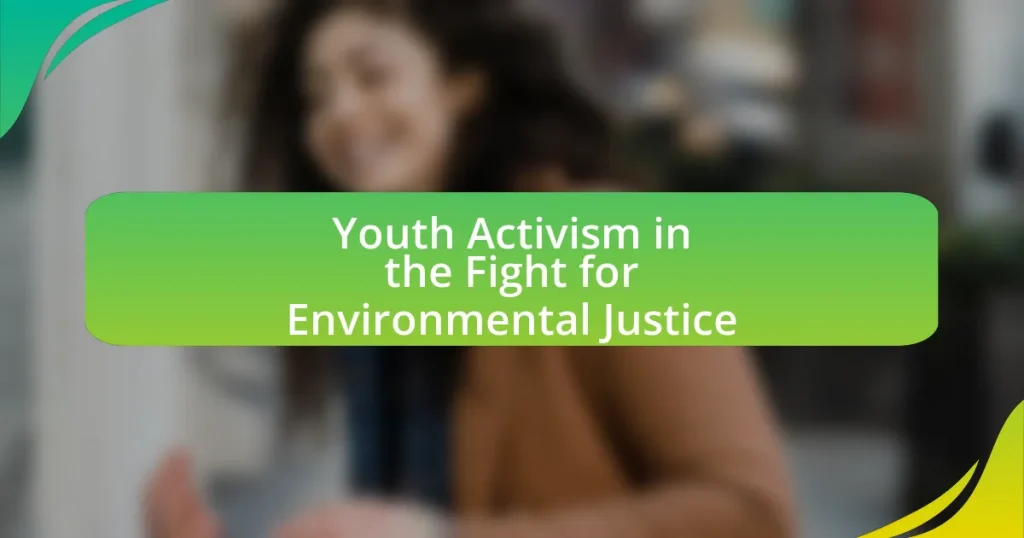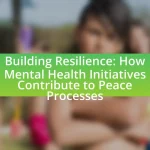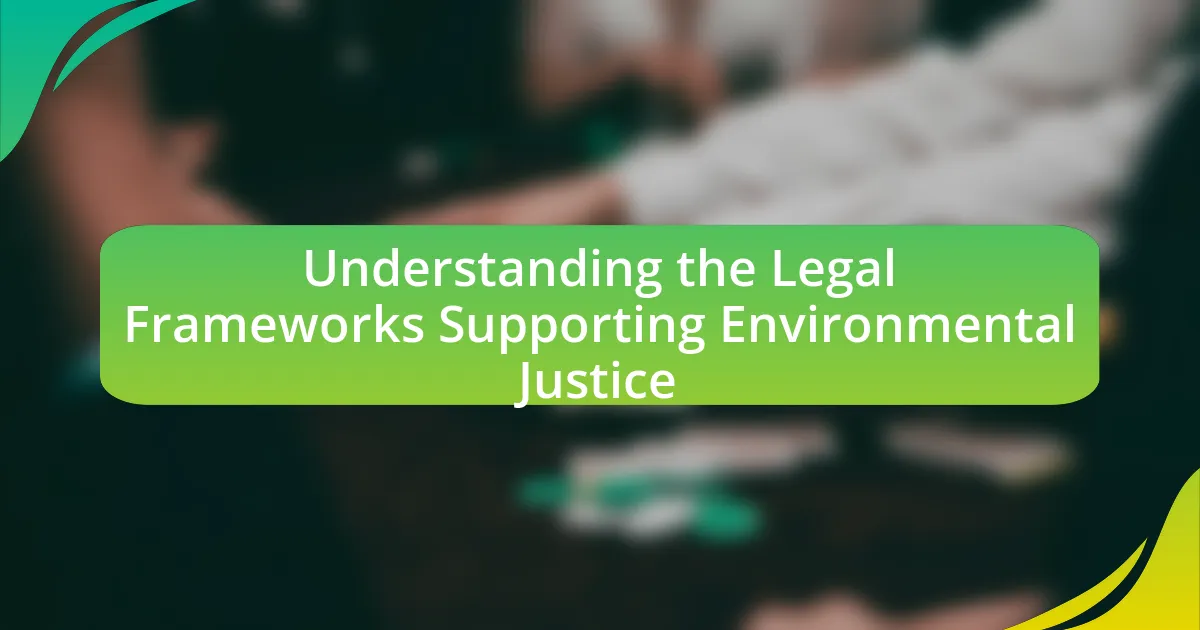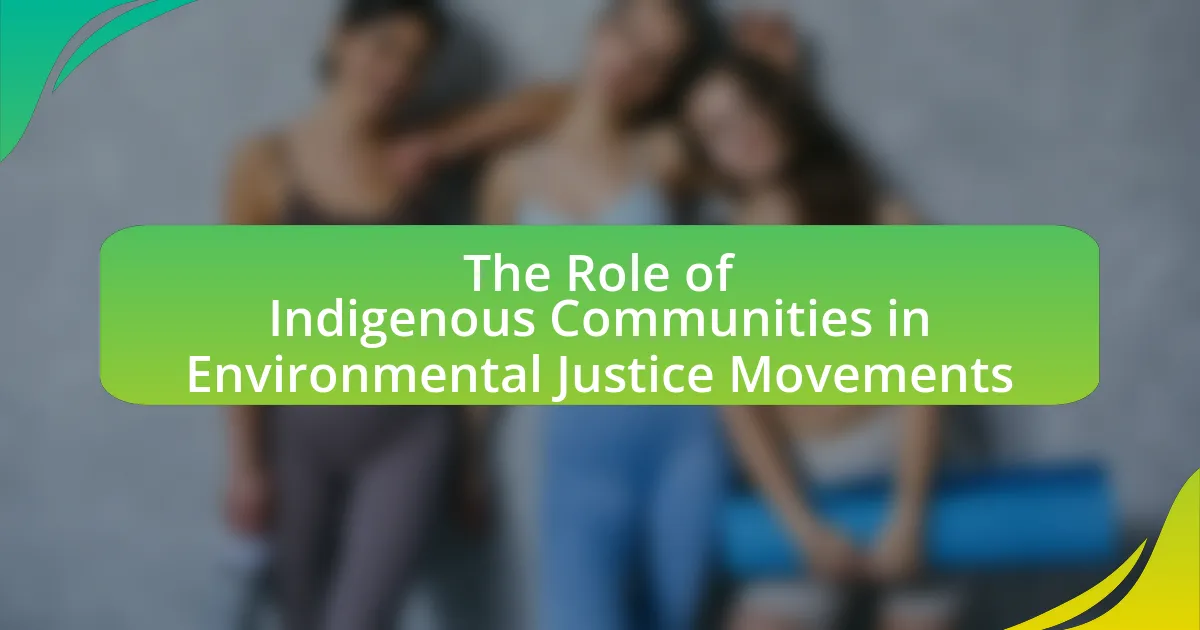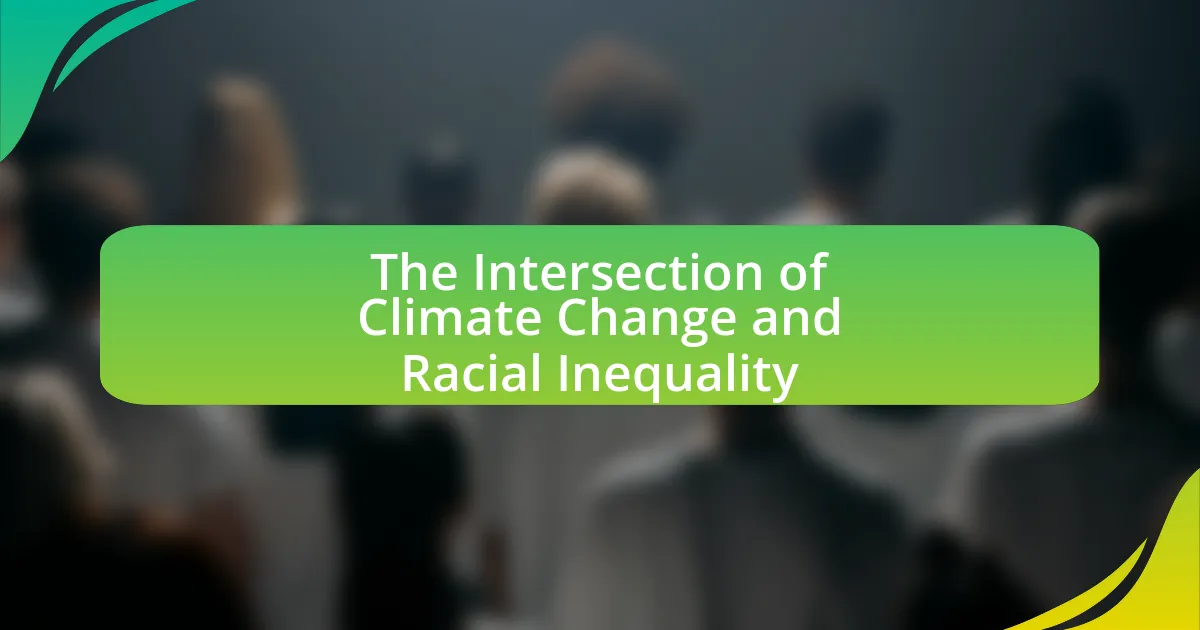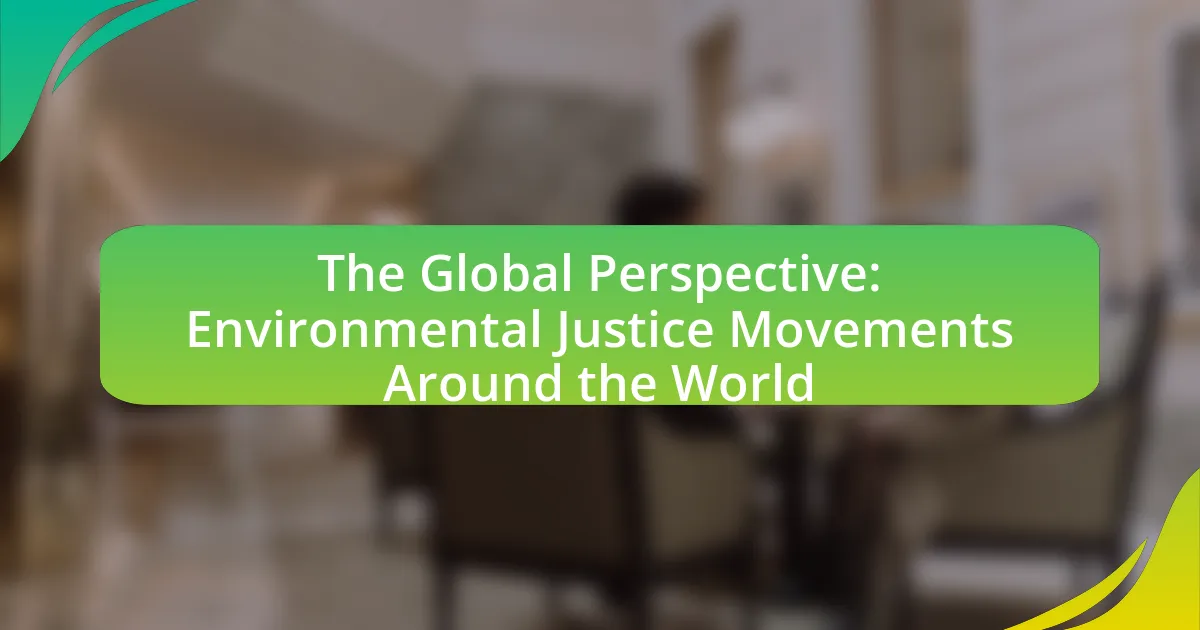Youth activism in the fight for environmental justice involves young individuals advocating for equitable environmental policies that address the disproportionate impact of environmental issues on marginalized communities. The article explores the evolution of youth activism, highlighting key historical events, cultural influences, and the unique perspectives young activists bring to the movement. It discusses the strategies employed by youth, including grassroots organizing and social media campaigns, as well as the challenges they face, such as funding limitations and age discrimination. Additionally, the article examines the role of grassroots organizations in supporting youth activism and the importance of building coalitions for greater impact in environmental justice initiatives.
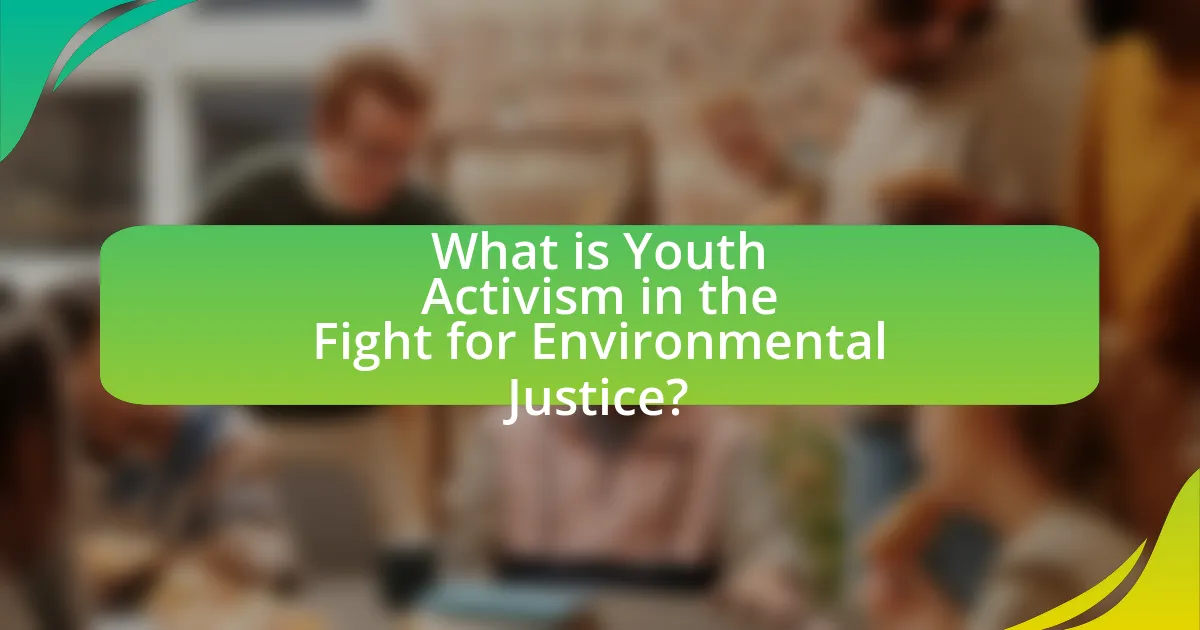
What is Youth Activism in the Fight for Environmental Justice?
Youth activism in the fight for environmental justice refers to the engagement and mobilization of young individuals advocating for equitable environmental policies and practices that address the disproportionate impact of environmental issues on marginalized communities. This activism is characterized by grassroots organizing, social media campaigns, and participation in global movements, such as the Fridays for Future initiative, which was inspired by Greta Thunberg’s school strike for climate action. Research indicates that youth-led movements have significantly influenced public discourse and policy changes, exemplified by the increased recognition of climate change as a pressing social justice issue.
How has youth activism evolved in the context of environmental justice?
Youth activism has evolved significantly in the context of environmental justice, transitioning from localized efforts to a global movement driven by digital platforms and social media. Initially, youth activism focused on community-specific issues, such as pollution and conservation efforts, but has expanded to encompass broader systemic challenges like climate change and social equity. This evolution is evidenced by the rise of global movements, such as Fridays for Future, initiated by Greta Thunberg in 2018, which mobilized millions of young people worldwide to demand urgent action on climate issues. Additionally, studies indicate that youth-led organizations are increasingly integrating social justice into environmental advocacy, recognizing the interconnectedness of environmental degradation and social inequality. This shift reflects a more holistic understanding of environmental justice, emphasizing the need for inclusive policies that address the needs of marginalized communities disproportionately affected by environmental harm.
What historical events have shaped youth activism in this area?
Historical events that have shaped youth activism in the fight for environmental justice include the 1969 Santa Barbara oil spill, which galvanized public awareness about environmental issues, and the 1992 Earth Summit in Rio de Janeiro, where youth organizations began to mobilize on a global scale. The Santa Barbara oil spill resulted in significant media coverage and led to the establishment of the Environmental Protection Agency, highlighting the need for environmental protection. The Earth Summit marked a pivotal moment for youth, as it provided a platform for young activists to voice their concerns and advocate for sustainable development. Additionally, the 2018 school strike for climate initiated by Greta Thunberg further energized youth activism, leading to global movements like Fridays for Future, demonstrating the ongoing impact of historical events on youth engagement in environmental justice.
How do cultural and social factors influence youth engagement?
Cultural and social factors significantly influence youth engagement by shaping their values, beliefs, and behaviors. For instance, cultural norms can dictate the importance of community involvement, encouraging youth to participate in activism. Social networks, including family and peers, also play a crucial role; studies show that youth are more likely to engage in social movements when they perceive support from their immediate social circles. Additionally, exposure to diverse perspectives through education and media can enhance awareness of social issues, motivating youth to take action. Research indicates that youth from collectivist cultures often demonstrate higher levels of civic engagement compared to those from individualistic cultures, highlighting the impact of cultural context on activism.
Why is youth activism crucial for environmental justice?
Youth activism is crucial for environmental justice because it mobilizes a generation that is directly affected by climate change and environmental degradation. Young activists bring urgency and innovative perspectives to the environmental movement, often highlighting issues that older generations may overlook. For instance, the global youth climate strikes, initiated by Greta Thunberg in 2018, have galvanized millions of young people worldwide, demonstrating their ability to influence public discourse and policy on climate action. Research indicates that youth-led movements can lead to significant policy changes; for example, in 2021, the U.S. saw increased climate action commitments partly due to youth advocacy. This engagement not only raises awareness but also pressures governments and corporations to adopt sustainable practices, making youth activism a vital force in the pursuit of environmental justice.
What unique perspectives do young activists bring to the movement?
Young activists bring fresh, innovative perspectives to the environmental justice movement by prioritizing inclusivity and leveraging digital platforms for advocacy. Their unique experiences often reflect a deep understanding of the intersectionality of social issues, recognizing how environmental degradation disproportionately affects marginalized communities. For instance, studies show that youth-led movements, such as the Sunrise Movement, emphasize the need for systemic change that addresses both climate change and social inequality, highlighting their ability to connect diverse issues. Additionally, young activists utilize social media effectively to mobilize support and raise awareness, as evidenced by the global reach of campaigns like Fridays for Future, which has engaged millions in climate strikes worldwide.
How does youth activism impact policy and public opinion?
Youth activism significantly influences policy and public opinion by mobilizing collective action and raising awareness on critical issues. For instance, movements like Fridays for Future, initiated by Greta Thunberg, have successfully pressured governments to adopt more stringent climate policies, evidenced by the increased commitments to carbon neutrality from various nations following youth-led protests. Additionally, surveys indicate that youth activism has shifted public opinion towards greater support for environmental initiatives, with a 2021 Pew Research Center study showing that 70% of young adults prioritize climate change as a pressing issue. This combination of grassroots mobilization and changing public sentiment demonstrates the powerful role of youth activism in shaping policy and societal attitudes regarding environmental justice.
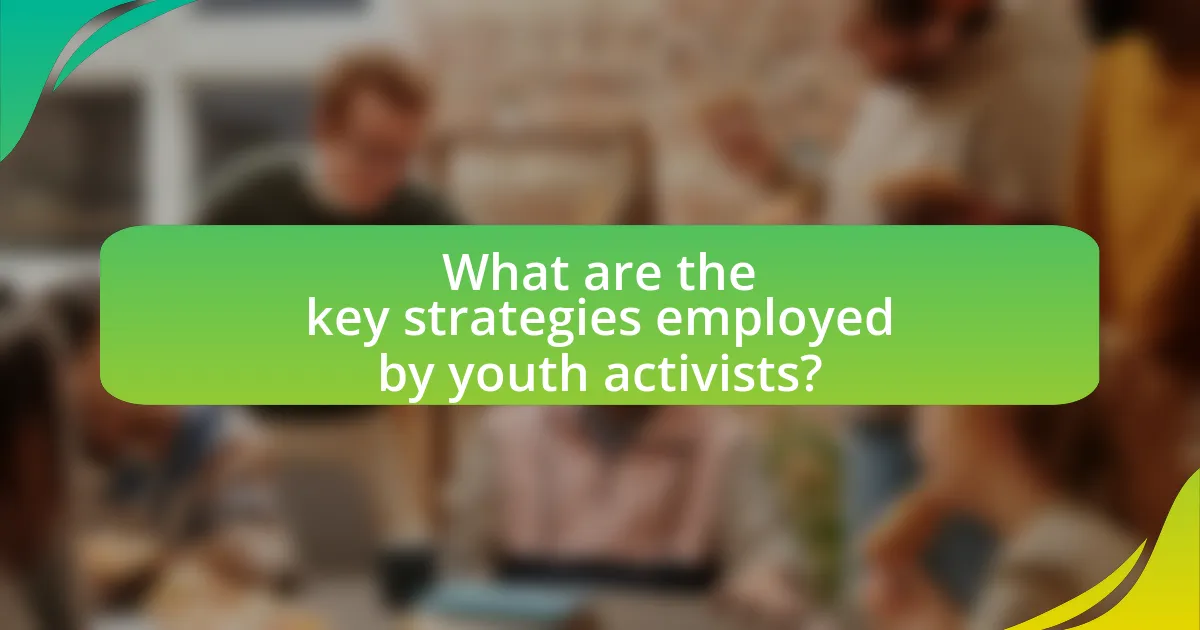
What are the key strategies employed by youth activists?
Youth activists employ several key strategies to advocate for environmental justice, including grassroots organizing, social media campaigns, and coalition-building. Grassroots organizing allows youth to mobilize their communities, raise awareness, and create local action plans. Social media campaigns amplify their messages, reaching a broader audience and engaging supporters through platforms like Instagram and Twitter. Coalition-building with established organizations enhances their influence and resources, enabling collaborative efforts to address systemic issues. These strategies have been effective in movements such as the global climate strikes initiated by youth activists, which mobilized millions worldwide and highlighted the urgency of climate action.
How do youth activists utilize social media for advocacy?
Youth activists utilize social media for advocacy by leveraging platforms to raise awareness, mobilize support, and engage in dialogue about environmental issues. They create and share content that highlights climate change, pollution, and sustainability, often using hashtags to increase visibility and connect with broader movements. For instance, the #FridaysForFuture movement, initiated by Greta Thunberg, gained global traction through social media, leading to millions participating in climate strikes. Additionally, youth activists use social media to organize events, share educational resources, and foster community engagement, effectively amplifying their message and influencing public opinion and policy.
What platforms are most effective for mobilizing support?
Social media platforms, particularly Instagram, Twitter, and Facebook, are the most effective for mobilizing support in youth activism for environmental justice. These platforms facilitate rapid information dissemination, community building, and engagement through visual content and hashtags. For instance, a study by the Pew Research Center in 2021 found that 69% of U.S. adults use Facebook, making it a powerful tool for organizing events and campaigns. Additionally, Instagram’s emphasis on visual storytelling has proven effective in raising awareness and inspiring action among younger demographics, as evidenced by the success of campaigns like #FridaysForFuture. Twitter’s real-time communication capabilities allow activists to quickly share updates and mobilize support during critical moments, further enhancing its effectiveness.
How do online campaigns translate into offline action?
Online campaigns translate into offline action by mobilizing individuals to participate in real-world activities, such as protests, community clean-ups, and advocacy meetings. For instance, social media platforms enable youth activists to share information, organize events, and rally support for environmental causes, leading to increased attendance at local events. A study by the Pew Research Center found that 69% of young people who engage in online activism also participate in offline activities, demonstrating a clear link between digital engagement and physical action. This connection is further evidenced by movements like the global climate strikes, where online calls to action resulted in millions of participants gathering in cities worldwide.
What role do grassroots organizations play in youth activism?
Grassroots organizations play a crucial role in youth activism by providing a platform for young people to engage in social and environmental issues. These organizations empower youth by facilitating education, mobilization, and advocacy efforts, enabling them to influence policy and raise awareness about environmental justice. For instance, organizations like Sunrise Movement have successfully organized youth-led campaigns that advocate for the Green New Deal, demonstrating the effectiveness of grassroots mobilization in shaping public discourse and policy. Additionally, grassroots organizations often foster a sense of community and solidarity among young activists, which is essential for sustaining long-term engagement in environmental justice initiatives.
How do these organizations support young activists?
Organizations support young activists by providing resources, training, and platforms for advocacy. They offer mentorship programs that connect experienced activists with youth, enhancing their skills in organizing and campaigning. For instance, organizations like the Sierra Club and Greenpeace conduct workshops focused on environmental issues, equipping young activists with knowledge and strategies to effect change. Additionally, these organizations often facilitate networking opportunities, allowing young activists to collaborate and amplify their voices on a larger scale, as seen in global movements like Fridays for Future, which mobilizes youth worldwide for climate action.
What partnerships are essential for successful campaigns?
Successful campaigns in youth activism for environmental justice require partnerships with local communities, non-profit organizations, educational institutions, and governmental agencies. These partnerships enhance resource sharing, amplify voices, and increase the reach of campaigns. For instance, collaboration with non-profit organizations can provide expertise and funding, while partnerships with educational institutions can facilitate research and mobilization of student activists. Engaging local communities ensures that campaigns are relevant and address specific environmental issues faced by those communities, thereby fostering grassroots support. Additionally, working with governmental agencies can help in navigating regulatory frameworks and gaining access to policy-making processes, which is crucial for enacting change.
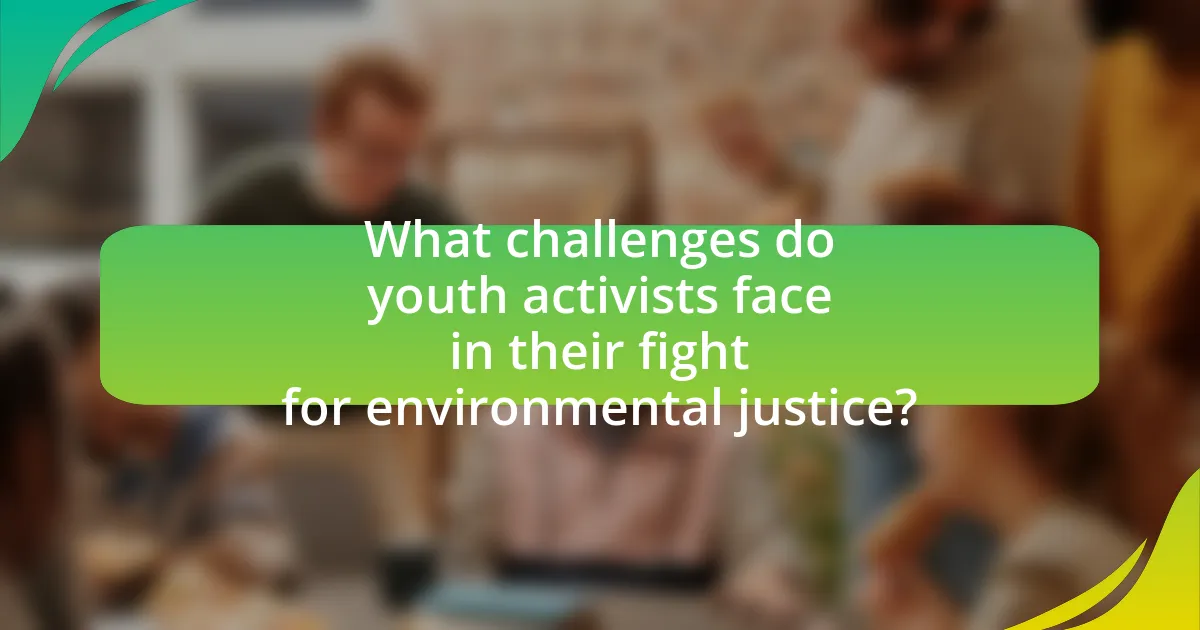
What challenges do youth activists face in their fight for environmental justice?
Youth activists face significant challenges in their fight for environmental justice, including lack of funding, limited access to decision-making processes, and resistance from established political and corporate entities. These activists often operate with minimal financial resources, which hampers their ability to organize campaigns and reach broader audiences. Additionally, youth voices are frequently marginalized in policy discussions, limiting their influence on critical environmental legislation. Resistance from powerful stakeholders, such as industries that prioritize profit over sustainability, further complicates their efforts, as these entities may actively work against the initiatives proposed by young activists.
How do systemic barriers hinder youth activism?
Systemic barriers hinder youth activism by creating obstacles that limit access to resources, decision-making processes, and platforms for expression. These barriers include socioeconomic disparities, lack of representation in political structures, and inadequate support from educational institutions. For instance, youth from marginalized communities often face financial constraints that prevent them from participating in activism, such as attending events or accessing necessary materials. Additionally, systemic issues like age discrimination can lead to the exclusion of young voices in policy discussions, undermining their ability to influence environmental justice initiatives. Research indicates that youth activism is significantly impacted by these barriers, as evidenced by studies showing that only 20% of young activists feel their opinions are valued in local governance, highlighting the need for systemic change to empower youth in their advocacy efforts.
What are the common obstacles related to funding and resources?
Common obstacles related to funding and resources in youth activism for environmental justice include limited access to financial support, lack of institutional backing, and competition for grants. Many youth-led initiatives struggle to secure funding due to the perception that they lack experience or credibility compared to established organizations. Additionally, youth activists often face challenges in navigating complex grant application processes, which can be time-consuming and resource-intensive. According to a report by the Global Youth Mobilization, 70% of youth-led projects reported difficulties in obtaining funding, highlighting the systemic barriers that hinder their efforts.
How does age discrimination affect youth participation?
Age discrimination negatively impacts youth participation by limiting their opportunities to engage in decision-making processes and activism. When young individuals are perceived as less capable or knowledgeable due to their age, they often face barriers that prevent them from contributing to important discussions, such as those surrounding environmental justice. Research indicates that youth involvement is crucial for effective advocacy, as their perspectives can drive innovative solutions. For instance, a study by the United Nations Environment Programme highlights that inclusive participation of youth leads to more comprehensive environmental policies. Thus, age discrimination not only marginalizes young voices but also undermines the effectiveness of movements aimed at addressing critical issues like environmental justice.
What personal challenges do young activists encounter?
Young activists encounter several personal challenges, including mental health issues, social isolation, and balancing activism with education or employment. These challenges stem from the emotional toll of advocating for urgent issues, such as climate change, which can lead to anxiety and burnout. A study published in the journal “Environmental Research Letters” highlights that young activists often feel overwhelmed by the scale of environmental crises, contributing to feelings of helplessness. Additionally, the commitment to activism can strain personal relationships, as peers may not share the same level of urgency or understanding. Balancing these responsibilities with academic or job obligations further complicates their ability to sustain their activism.
How do mental health issues impact their activism?
Mental health issues significantly impact youth activism by affecting emotional resilience, motivation, and the ability to engage in sustained efforts. Activists facing mental health challenges may experience increased stress, anxiety, and burnout, which can hinder their participation in campaigns and initiatives. For instance, a study published in the Journal of Environmental Psychology found that young activists often report feelings of hopelessness and overwhelm when confronting climate change, leading to decreased activism engagement. This correlation highlights how mental health can directly influence the effectiveness and sustainability of youth-led movements for environmental justice.
What strategies do activists use to cope with burnout?
Activists cope with burnout by implementing self-care practices, establishing boundaries, and fostering community support. Self-care practices include regular physical activity, mindfulness techniques, and adequate rest, which help maintain mental and emotional well-being. Establishing boundaries involves setting limits on work hours and learning to say no to additional responsibilities, preventing overwhelm. Fostering community support allows activists to share experiences and resources, creating a network of encouragement and understanding. Research indicates that these strategies can significantly reduce stress and enhance resilience among activists, promoting sustained engagement in their causes.
What are the best practices for effective youth activism?
Effective youth activism involves organizing, educating, and mobilizing peers around specific issues. Youth activists should focus on building coalitions with like-minded organizations to amplify their voices and reach a broader audience. Engaging in social media campaigns is crucial, as platforms like Instagram and Twitter can effectively spread awareness and rally support.
Additionally, youth activists should prioritize research and fact-based advocacy to ensure their messages are credible and impactful. For instance, the 2019 Global Climate Strike, led by youth activists, demonstrated the power of collective action, mobilizing millions worldwide to demand climate action. This event highlighted the effectiveness of strategic planning and collaboration in youth-led movements.
Furthermore, developing leadership skills through workshops and mentorship can empower young activists to take initiative and sustain their efforts over time. By employing these best practices, youth can significantly influence environmental justice initiatives and policy changes.
How can young activists build coalitions for greater impact?
Young activists can build coalitions for greater impact by identifying shared goals and values among diverse groups. This involves engaging in open dialogue to understand different perspectives, which fosters trust and collaboration. For instance, the Sunrise Movement successfully united various youth-led organizations around the Green New Deal, demonstrating that a common vision can mobilize collective action. Additionally, leveraging social media platforms enhances outreach and facilitates connections, as seen in the global climate strikes organized by youth activists in 2019, which brought millions together across different countries. By focusing on inclusivity and strategic partnerships, young activists can amplify their voices and drive significant change in environmental justice initiatives.
What skills are essential for successful advocacy efforts?
Successful advocacy efforts require strong communication skills, strategic planning, and the ability to mobilize and engage communities. Effective communication enables advocates to convey their messages clearly and persuasively, which is crucial for raising awareness and influencing public opinion. Strategic planning involves setting clear goals, identifying target audiences, and developing actionable steps to achieve desired outcomes. Additionally, the ability to mobilize and engage communities fosters collective action, which is essential for driving change in environmental justice initiatives. These skills are supported by numerous successful advocacy campaigns that have demonstrated the importance of clear messaging, organized efforts, and community involvement in achieving impactful results.
